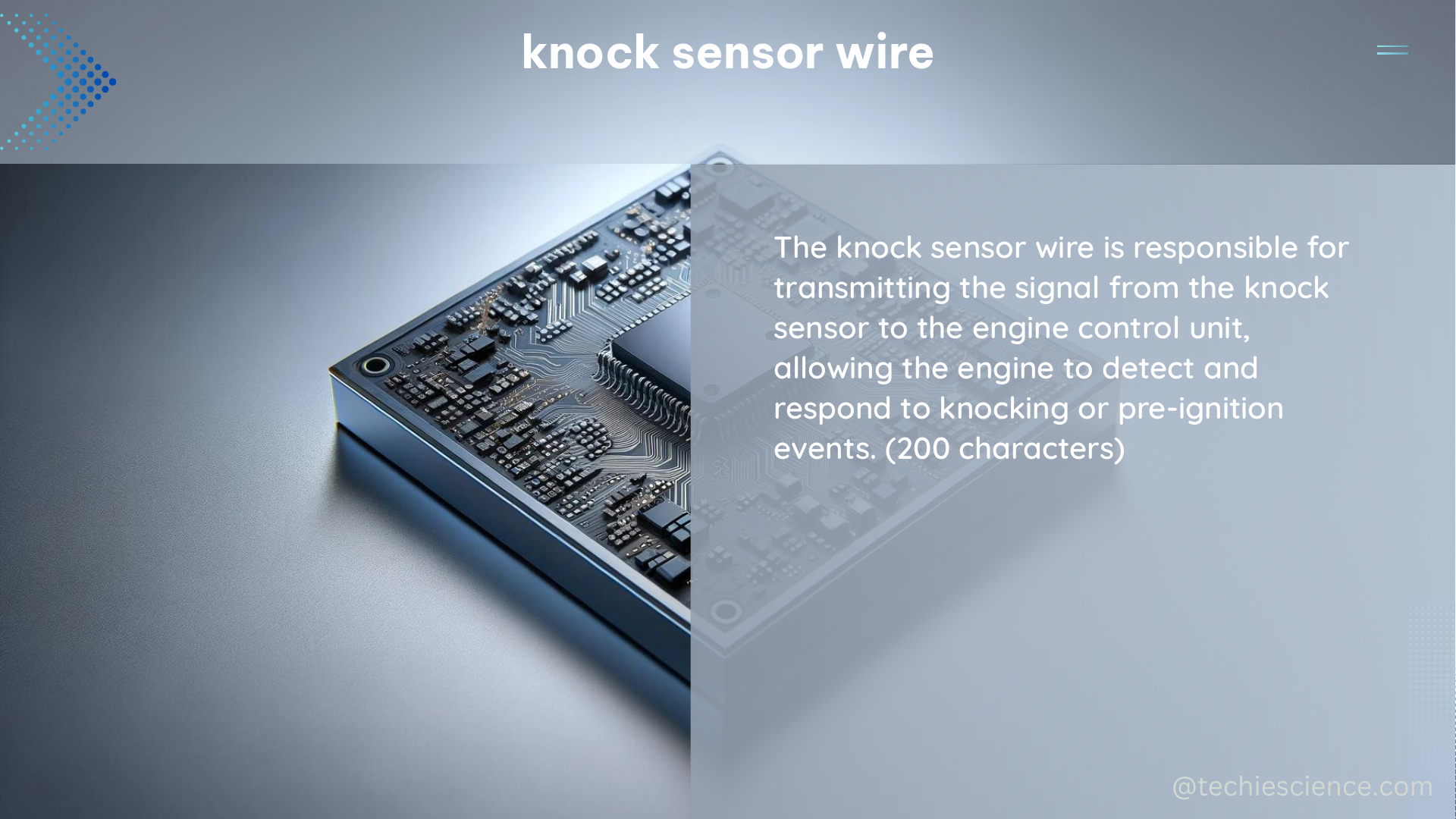The knock sensor wire, also known as the crankshaft position sensor wire, is a critical component in modern vehicles’ engine management systems. It is responsible for transmitting signals from the knock sensor to the engine control unit (ECU) to detect engine knocking or detonation, which can have severe consequences if left unaddressed.
Understanding the Principles of Knock Sensor Wire Operation
The knock sensor wire operates based on the principle of inductive sensing. It is positioned above the impulse wheel, which is connected to the wheel hub or drive shaft. As the impulse wheel rotates, it causes a change in the magnetic field, which induces a quantifiable alternating voltage in the winding of the knock sensor wire. The frequency and amplitudes of this alternating voltage are directly related to the wheel speed.
Technical Specifications of Knock Sensor Wire
The technical specifications of the knock sensor wire include:
- Voltage Range: The knock sensor wire must operate within a specific voltage range for signal detection, as defined by the control unit. This voltage range is typically between 0.5 and 5 volts.
- Sensor-Impulse Wheel Gap: The gap between the knock sensor and the impulse wheel is provided by the axle design, and it is crucial for the proper functioning of the sensor. This gap is typically between 0.5 and 1.5 millimeters.
- Electrical Connection: The knock sensor wire is connected to the control unit via a two-pole electric connecting cable, which transmits the sensor’s signals to the ECU.
Diagnosing Knock Sensor Wire Issues

Diagnosing a malfunctioning knock sensor wire requires specific manufacturers’ specifications and the specifications of the respective vehicle manufacturer. Common diagnostic tools used for this purpose include:
- Multimeter: A multimeter can be used to measure the voltage output of the knock sensor wire, which should be within the specified range.
- Ohmmeter: An ohmmeter can be used to check the resistance of the knock sensor wire, which should be within the manufacturer’s recommended range, typically between 800 and 1,200 ohms.
- Oscilloscope: An oscilloscope can be used to analyze the waveform of the alternating voltage generated by the knock sensor wire, which should have a consistent frequency and amplitude.
- Diagnostic Unit: A diagnostic unit, such as an engine control module (ECM) or a dedicated diagnostic tool, can be used to read and interpret the sensor’s signals and identify any fault codes related to the knock sensor wire.
Quantifiable Data and Measurements
The knock sensor wire generates an alternating voltage with specific frequencies and amplitudes that are directly related to the wheel speed. These signals can be measured and analyzed to diagnose any issues with the sensor or the engine management system. Some key data points and measurements include:
- Voltage Output: The knock sensor wire should generate an alternating voltage within the specified range, typically between 0.5 and 5 volts.
- Frequency: The frequency of the alternating voltage should be directly proportional to the wheel speed, with a typical range of 10 to 100 Hz.
- Amplitude: The amplitude of the alternating voltage should be consistent and within the manufacturer’s recommended range, typically between 0.5 and 2 volts.
- Resistance: The resistance of the knock sensor wire should be within the specified range, typically between 800 and 1,200 ohms.
Importance of Knock Sensor Wire in Engine Management
The knock sensor wire plays a crucial role in the engine management system of modern vehicles. It is responsible for detecting engine knocking or detonation, which can lead to severe engine damage if left unaddressed. By monitoring the signals from the knock sensor wire, the ECU can adjust the ignition timing and fuel delivery to prevent knocking and ensure optimal engine performance.
Conclusion
The knock sensor wire is a critical component in modern vehicles’ engine management systems, responsible for transmitting signals from the knock sensor to the ECU. Understanding the technical specifications, diagnostic procedures, and quantifiable data associated with the knock sensor wire is essential for maintaining the health and performance of your vehicle’s engine. By following the guidelines and best practices outlined in this comprehensive guide, you can effectively diagnose and address any issues related to the knock sensor wire, ensuring your vehicle’s optimal performance and longevity.
Reference:
– AETC Technical Training Publication 11-1
– Hella Technical World – Check and Change ABS Sensor
– AI4SES Report 2023

The lambdageeks.com Core SME Team is a group of experienced subject matter experts from diverse scientific and technical fields including Physics, Chemistry, Technology,Electronics & Electrical Engineering, Automotive, Mechanical Engineering. Our team collaborates to create high-quality, well-researched articles on a wide range of science and technology topics for the lambdageeks.com website.
All Our Senior SME are having more than 7 Years of experience in the respective fields . They are either Working Industry Professionals or assocaited With different Universities. Refer Our Authors Page to get to know About our Core SMEs.